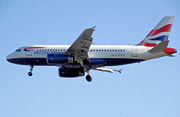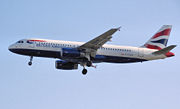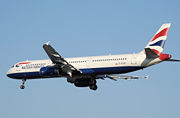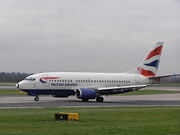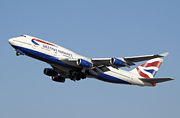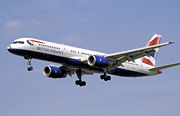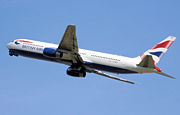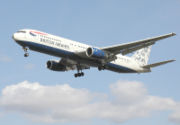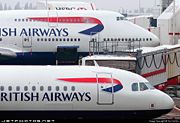British Airways
2008/9 Schools Wikipedia Selection. Related subjects: Companies
| British Airways | ||
|---|---|---|
| |
||
| IATA BA |
ICAO BAW SHT XMS |
Callsign SPEEDBIRD SHUTTLE SANTA |
| Founded | 1924 (as Imperial Airways) | |
| Hubs | London Heathrow Airport London Gatwick Airport |
|
| Frequent flyer program | Executive Club | |
| Member lounge | Terraces Lounge Arrivals lounge First Lounge Concorde Room (LHR and JFK Only) |
|
| Alliance | Oneworld | |
| Fleet size | 237 (49 Orders) | |
| Destinations | 222 | |
| Parent company | British Airways plc | |
| Headquarters | London, England, UK | |
| Key people | Willie Walsh ( Chief Executive) | |
| Website: http://www.britishairways.com | ||
British Airways plc (LSE: BAY, NYSE: BAB) is the largest airline and flag carrier of the United Kingdom and one of the largest in Europe. Its main hubs are London Heathrow and London Gatwick. British Airways plc holds a United Kingdom Civil Aviation Authority Type A Operating Licence, and is permitted to carry passengers, cargo and mail on aircraft with 20 or more seats. British Airways is a founding member of the Oneworld airline alliance.
History
On 31 March 1924, Britain's four pioneer airlines - Instone Air Line, Handley Page Transport, Daimler Airways (a successor to AT&T) and British Air Marine Navigation - merged to form Imperial Airways, which developed its Empire routes to Australia and Africa.
Meanwhile a number of smaller UK air transport companies had started flights. These merged in 1935 to form the original privately owned British Airways Ltd. Following a government review, Imperial Airways and British Airways were nationalised in 1939 to form the British Overseas Airways Corporation (BOAC). Post-war, BOAC continued to operate long-haul services, other than routes to South America - these were flown by British South American Airways, which was merged back into BOAC in 1949. Continental European and domestic flights were flown by a new nationalised airline, British European Airways (BEA), which compulsorily took over the routes of existing UK independent airlines.
In 1952 BOAC flew the De Havilland Comet to Johannesburg, halving the previous flight time. The birth of the mass package-holiday business meant change for the airline industry. BEA met the challenge by establishing BEA Airtours in 1970. In 1972 BOAC and BEA were combined under the newly formed British Airways Board, with the separate airlines coming together as British Airways in 1974, under the guidance of David Nicolson as Chairman of the BA Board. British Airways, simultaneously with Air France, inaugurated the world's first supersonic passenger service with Concorde in January 1976.
Privatisation
Sir John King, later Lord King, was appointed as Chairman in 1981 with the mission of preparing the airline for privatisation. King hired Colin Marshall as CEO in 1983. King was credited with turning around the loss-making giant into one of the most profitable air carriers in the world, boldly claiming to be "The World's Favourite Airline", while many other large airlines struggled. The airline's fleet and route map were overhauled in the early years of King's tenure, with brand and advertising experts being recruited to change the airline's image. Over 23,000 jobs were shed in the early 1980s, though King managed the considerable trick of boosting staff morale and modernising operations at the same time. Offering generous inducements for people to leave led to record losses of £545 million, to the cost of taxpayers but to the benefit of the future privatised company.
The flag carrier was privatised and floated on the London Stock Exchange in February 1987 by the Conservative government, with the initial share offering being 11 times oversubscribed. In April 1988 British Airways effected the controversial takeover of Britain's airline British Caledonian, and in 1992 absorbed some of the routes of Gatwick-based carrier Dan-Air.
"Dirty tricks"
Soon after BA's privatisation, Richard Branson's Virgin Atlantic, which began with one route and one Boeing 747 in 1984, was beginning to emerge as a competitor on some of BA's most lucrative routes. Following Virgin's highly publicised mercy mission to Iraq to fly home hostages of Saddam Hussein in 1991, King is reported to have told Marshall and his PA Director David Burnside to "do something about Branson". This began the campaign of "dirty tricks" that ended in Branson suing King and British Airways for libel in 1992. King countersued Branson and the case went to trial in 1993. British Airways, faced with likely defeat, settled the case, giving £500,000 to Branson and a further £110,000 to his airline; further, BA was to pay the legal fees of up to £3 million. Branson divided his compensation among his staff, the so-called "BA bonus".
Changes and subsidiaries
During the 1990s BA became the world's most profitable airline under the slogan "The World's Favourite Airline". In 1992 BA purchased the small German domestic airline Delta Air Transport and renamed it Deutsche BA. By the time it was sold in June 2003, DBA was operating 16 Boeing 737s and was the second-largest German domestic carrier, after Lufthansa.
Lord King stepped down as chairman in 1993 and was replaced by former deputy Colin Marshall, who initially combined the roles of CEO and Chairman. Bob Ayling, who would later take on the role of CEO, was appointed Managing Director by Marshall. Lord King was appointed President, a role created specifically for him, and became President Emeritus in 1997, until his death in July 2005.
In 1995 BA formed British Asia Airways, a subsidiary based in Taiwan, to operate between London and Taipei. Owing to political sensitivities, British Asia Airways not only had a different name, but also had a different livery, with the Union Jack tailfin being replaced by Chinese characters. Many airlines followed the same practice, e.g. Qantas flew to Taiwan as "Australia Asia Airways" and KLM's Taiwan operations became "KLM Asia". British Asia Airways ceased operation in 2001 when the airline suspended flights to Taiwan due to low yield.
Bob Ayling era
In 1996 British Airways, with its newly appointed Chief Executive Bob Ayling, entered a period of turbulence. Increased competition, high oil prices and a strong pound hurt profits. BA management and trade unions clashed and the disruption cost the company hundreds of millions of pounds. In 1997 Ayling dropped BA's traditional Union Flag tailfin livery in favour of world design tailfins, in an effort to change its image from a strictly British and aloof carrier to a more cosmopolitan airline. The move was not a success and Ayling slowed the process, eventually declaring the fleet would sport a dual livery; half a Union Flag design, half the world design tailfins. Ayling pursued antitrust immunity with American Airlines, but this was unsuccessful due to the conditions placed on the deal by regulatory authorities, the most painful of which would have been the sacrifice of landing slots at Heathrow.
Positive news during Ayling's leadership included cost savings of £750m and the establishment of the successful, but highly subsidised, Go in 1998. Go was a low-cost carrier intended to compete in the rapidly emerging "no-frills" segment. After four years of successful operations, the airline was sold off to venture capitalists 3i and later merged with EasyJet. Ayling also sought a reduction of capacity, cancelling Boeing 747-400 orders in favour of the Boeing 777 and rationalising BA's short-haul fleet with an order for the Airbus A319/A320/A321 family.
Rod Eddington era
In 1999 British Airways reported a 50% slump in profits, its worst since privatisation. In March 2000 Bob Ayling was removed from his position. British Airways announced Rod Eddington as his successor in May. Eddington set about cutting the workforce further, dramatically so after the slump caused by the 11 September attacks in 2001.
On 8 September 2004 British Airways announced that it was to sell its 18.5% stake in Qantas, but would continue the alliance (such as sharing revenue), particularly on the Kangaroo routes. The £425 million raised was used to reduce the airline's debt.
Marshall, who had been appointed a life peer in 1998, retired as Chairman in July 2004 and was replaced by Martin Broughton, former Chairman of British American Tobacco. On 8 March 2005, Broughton announced that former Aer Lingus CEO Willie Walsh would take over from Rod Eddington upon his retirement in September 2005.
Willie Walsh era
In September 2005 new CEO Willie Walsh announced dramatic changes to the management of British Airways, with the aim of saving £300 million by 2008, the cost of the move to Heathrow's Terminal 5. He has presided over the disposal of BA Connect to Flybe, with Walsh stating "Despite the best efforts of the entire team at BA Connect, we do not see any prospect of profitability in its current form." BA has retained a 15% stake in Flybe following the sale.
Since 2004, BA has strongly marketed the full-service nature of its domestic flights (i.e the use of principal airports, free food and drink) in response to the low cost operators aggressive pricing, even though its main full-service UK rival bmi has now abandoned some "frills" on its domestic network. Walsh on the other hand pledged to retain the full-service model, and sees it as a means of distinguishing BA from the competition and that customers will still be willing to pay extra for added levels of service.
The airline won the Skytrax Airline of the Year award in 2006 for the first time. It also won OAG Airline of the Year 2007, Best Airline Based in Western Europe 2007, Best Transatlantic Airline 2007, and Best Europe - Asia/Australasia Airline 2007' in the Airline of the Year Awards run by UK-based OAG. However the Airport Transport Users Council rate BA as the worst European carrier for baggage handling. BAs London Heathrow baggage system has insufficient capacity to deal with the number of bags passing through it, according to BBC news. BA lost on average 3000 pieces of baggage per day.
Price-fixing
On the 1 August 2007, British Airways was fined £121.5 million for price-fixing. The fine was imposed by the Office of Fair Trading (OFT) after BA admitted to the price-fixing of fuel surcharges on long haul flights. The allegation first came to light in 2006 when Virgin Atlantic reported the events to the authorities after it found staff members from BA and Virgin Atlantic were colluding. Virgin Atlantic have since been granted immunity by both the OFT and the United States Department of Justice who have been investigating the allegations since June 2006. The US DOJ later announced that it would fine British Airways $300 million (£148 million) for price fixing.
The allegations are thought to be linked to the resignation of commercial director Martin George and communications chief Iain Burns. Although BA said fuel surcharges were "a legitimate way of recovering costs", in May 2007 it put aside £350 million for legal fees and fines.
Financial performance
| Year Ended | Passengers Flown | Turnover (£m) | Profit/Loss Before Tax (£m) | Net Profit/Loss (£m) | Basic EPS (p) |
|---|---|---|---|---|---|
| March 31, 2007 | 33,068,000 | 8,492 | 611 | 438 | 25.5 |
| March 31, 2006 (Restated)* | 32,432,000 | 8,213 | 616 | 464 | 40.4 |
| March 31, 2006 | 35,634,000 | 8,515 | 620 | 467 | 40.4 |
| March 31, 2005 | 35,717,000 | 7,772 | 513 | 392 | 35.2 |
| March 31, 2004 | 36,103,000 | 7,560 | 230 | 130 | 12.1 |
| March 31, 2003 | 38,019,000 | 7,688 | 135 | 72 | 6.7 |
| March 31, 2002 | 40,004,000 | 8,340 | (200) | (142) | (13.2) |
| March 31, 2001 | 36,221,000 | 9,278 | 150 | 114 | 10.5 |
| March 31, 2000 | 36,346,000 | 8,940 | 5 | (21) | (2.0) |
| March 31, 1999 | 37,090,000 | 8,915 | 225 | 206 | 19.5 |
| March 31, 1998 | 34,377,000 | 8,642 | 580 | 460 | 44.7 |
| March 31, 1997 | 33,440,000 | 8,359 | 640 | 553 | 55.7 |
| March 31, 1996 | 32,272,000 | 7,760 | 585 | 473 | 49.4 |
* Restated for the disposal of the regional business of BA Connect.
Destinations
| Origin | Destination | Start Date | End Date | Notes |
|---|---|---|---|---|
| London Heathrow | Detroit | 29 March 2008 | Suspended due to low yields. | |
| Detroit | Houston | 29 March 2008 | Suspended due to low yields. | |
| London Gatwick | Aberdeen | 29 March 2008 | ||
| London Gatwick | Keflavik | 29 March 2008 | ||
| London Gatwick | Nice | 29 March 2008 | ||
| London Gatwick | Prague | 29 March 2008 | ||
| London Gatwick | Split | 29 March 2008 | ||
| London Heathrow | Warsaw | 26 March 2008 | Moved to London Gatwick | |
| London Gatwick | Houston | 29 March 2008 | Moved to London Heathrow | |
| London Gatwick | Dallas-Fort Worth | 29 March 2008 | Moved to London Heathrow | |
| London Gatwick | Algiers | 29 March 2008 | Moved to London Heathrow | |
| London Heathrow | Houston | 30 March 2008 | Moved from London Gatwick | |
| London Heathrow | Dallas-Fort Worth | 30 March 2008 | Moved from London Gatwick | |
| London Heathrow | Algiers | 30 March 2008 | Moved from London Gatwick | |
| London Gatwick | Warsaw | 27 March 2008 | Moved from London Heathrow | |
| London Heathrow | Malaga | 30 March 2008 | ||
| London Gatwick | Alicante | 30 March 2008 | ||
| London Gatwick | Faro | 30 March 2008 | ||
| London Gatwick | Gibraltar | 30 March 2008 | ||
| London Gatwick | Malaga | 30 March 2008 | ||
| London Gatwick | Malta | 30 March 2008 | ||
| London Gatwick | Palma de Mallorca | 30 March 2008 | ||
| London Gatwick | Poznan | 30 March 2008 | ||
| London Gatwick | Tunis | 30 March 2008 | ||
| London Gatwick | Genoa | 4 April 2008 | ||
| London Gatwick | Antalya | 10 April 2008 | ||
| London Gatwick | Ibiza | 10 June 2008 | ||
| London Gatwick | Paphos | 10 July 2008 | ||
| London Heathrow | Hyderabad | 27 October 2008 |
- From March 30, 2008 frequencies will be increased on flights from London Gatwick to Orlando and from London Heathrow to New York JFK, Seattle, and Washington-Dulles. As a result services from London Gatwick to Bridgetown and Port of Spain will be reduced.
Fleet

With the exception of the Boeing 707 and Boeing 747 from BOAC, the airline as formed in 1972-4 inherited a mainly British built fleet of aircraft. The airline introduced the Boeing 757 and Boeing 737 into the fleet in the 1980s, followed by the Boeing 747-400, Boeing 767 and Boeing 777 in the nineties. However, with the exception of 29 of its 777 fleet, it has often equipped its Boeing aircraft with British-made Rolls-Royce engines (examples include the Trent 800 on its Boeing 777s, the RB211-524 on its 747-400s and 767s and also RB211-535s on its 757-200s). This goes back to the 1960s when the company ordered Boeing 707s - a condition was placed on the company that it used Rolls-Royce power for the new jets. BA inherited BOAC's Boeing airline code (36). Boeing aircraft built for British Airways have the suffix 36, for example 737-236, 747-436, 777-236.
Although it had a large Boeing fleet it has always operated other aircraft. British built aircraft were transferred from BEA (e.g. Trident) and BOAC (e.g. VC10), and in the 1980s the airline bought the Lockheed Tristar. It has also acquired through the buyout of British Caledonian Airways in the 1980s the McDonnell Douglas DC-10 and Airbus A320. In the late 1990s British Airways placed its own first direct Airbus order, for over 100 A320/A319s to replace its own aging fleet of Boeing 737s. In September 2007 BA placed its first order for longhaul Airbus jets, 12 Airbus A380s with 7 options.
BA was one of only two operators of the supersonic Aerospatiale-BAC Concorde supersonic airliner, (the other being the state-owned Air France) with a daily service between Heathrow and New York JFK (although the original service was from London to Bahrain). Initially, Concorde was a financial burden, placed on the national carrier by the government, and attracted criticism from the press as a white elephant. However Lord King recognised the charismatic importance of Concorde to British Airways. BA used Concorde to win business customers, guaranteeing a certain number of Concorde upgrades in return for corporate accounts with the airline - a key factor in winning business from transatlantic competitors.
With the Paris Crash in 2000, the September 11, 2001 attacks and escalating maintenance costs, the future of Concorde was limited despite the expensive modifications after the crash. It was announced (on 10 April 2003) that, after 24 October 2003, they would cease scheduled services with Concorde, due to depressed passenger numbers. The last day of its Saturday-only London Heathrow to Barbados Concorde flight was on 30 August 2003. The airline still owns 8 Concordes which are on long term loan to museums in the UK, U.S. and Barbados.
The British Airways fleet includes the following aircraft as of September 2007:
| Aircraft | Total | Passengers (First/Business/Premium Economy/Economy) |
Routes | Notes |
|---|---|---|---|---|
| Airbus A319-100 | 33 | 132 | LHR to Europe and UK | Some moving to LGW from Autumn 2008 pending delivery of new Airbus A320 |
| Airbus A320 | 26 (8 orders) |
149 150 156 |
LHR to Europe and UK | |
| Airbus A321 | 11 (1 orders) |
194 | LHR to Europe and UK | |
| Airbus A380-800 | (12 orders) (7 options) |
- | - | Entry into service: 2012 |
| Boeing 737-300 | 5 | 126 | LGW to Europe and UK | Exit from service: 2009 Replacement aircraft: Airbus A319 |
| Boeing 737-400 | 19 | 147 | LGW to Europe and UK | |
| Boeing 737-500 | 9 | 110 | LGW to Europe and UK | Exit from service: 2009 Replacement aircraft: Airbus A319 |
| Boeing 747-400 | 57 | 291 (14/70/30/177) 299 (14/70/30/185) 337 (14/52/36/235) 351 (14/38/36/263) |
LHR to Africa, Asia, Australasia, Caribbean, North America and South America | BA has the largest fleet of -400 series 747s in the world. |
| Boeing 757-200 | 13 | 180 | LHR to Europe and UK | 6 aircraft will transferred to ' OpenSkies' subsidary by end of 2009 |
| Boeing 767-300ER | 21 | 173 (-/24/24/125) 252 (252) |
LHR and MAN to Africa, Caribbean, Europe and North America | Exit from Service: from 2010 Replacement aircraft: Boeing 787 |
| Boeing 777-200 | 3 | 229 (14/48/40/127) | LHR to Africa, Asia and North America | |
| Boeing 777-200ER | 40 (4 orders) (4 options) |
280 (-/40/24/216) 224 (14/48/40/122) 290 (-/38/40/212) |
LGW and LHR to Africa, Asia, Australasia, Caribbean and North America | Mix of Rolls Royce (RR) and General Electric (GE) powerplants |
| Boeing 787-8 | (8 orders) (16 options, 10 rights, for 787 family) |
Rolls Royce (RR) Trent 1000 powerplants Entry into service: 2010 Replaces 767-300ER |
||
| Boeing 787-9 | (16 orders) (16 options, 10 rights, for 787 family) |
Rolls Royce (RR) Trent 1000 powerplants Entry into service: 2010 Replaces 767-300ER |
Details of the fleet of British Airways subsidiary BA CityFlyer can be found in the related article. Details of the fleets of British Airways' franchises which use the British Airways name and logo can be found on articles: Loganair (until October 2008), Sun Air, Comair and GB Airways (until March 2008). In March 2007, the average age of British Airways fleet was 9.8 years.
British Airways offers either three or four classes of service on their long haul international routes. World Traveller (Economy Class), World Traveller Plus (Premium Economy) and Club World (Business Class) always feature. All Boeing 747 aircraft and most Boeing 777 aircraft are also fitted with FIRST (First Class).
Aircraft operated
The airline has operated the following aircraft (with in-service date):
- 1974 - BAC One-Eleven
- 1974 - Boeing 707-436
- 1974 - Boeing 747-136
- 1974 - Hawker Siddeley Trident
- 1974 - Lockheed Tristar 1
- 1974 - Vickers VC10
- 1974 - Vickers Viscount
- 1976 - Aérospatiale-BAC Concorde
- 1977 - Boeing 747-236
- 1980 - Boeing 737-236
- 1980 - Lockheed Tristar 500
- 1983 - Boeing 757-236
- 1988 - Douglas DC-10-30
- 1988 - Airbus A320-100
- 1989 - Boeing 747-400
- 1990 - Boeing 767-336
- 1991 - Boeing 737-436
- 1997 - Boeing 777-200
- 1999 - Airbus A319
- 2000 - Boeing 737-536
- 2001 - Boeing 737-336
- 2002 - Airbus A320-200
- 2004 - Airbus A321
Future
British Airways has 32 outstanding options with Airbus, which may be taken as any member of the A320 family. Secured delivery positions on 10 Boeing 777 aircraft are held.
On 18 May 2007, BA announced that it has placed a firm order with Airbus for eight new A320 aircraft. The new aircraft are due for delivery from 2008. They will be delivered to LHR displacing A319s to LGW which in turn will replace elderly Boeing 737-300/500, the leases on which expire at this time. aircraft
On 27 March 2007, British Airways placed a firm order for four 777-200ER aircraft with an option for four more, with the order totalling more than US$800 million at list price. The company has stated that these are for fleet expansion. BA's first batch of 777 were fitted with General Electric GE90 engines, but BA switched to Rolls Royce Trent 800s for the most recent 16 aircraft. This has been continued with the most recent 4 orders as Trent 800 engines were selected as the engine choice.
On 27 September 2007, BA announced their biggest order since 1998 by ordering 36 new long haul aircraft. The company ordered 12 A380s with options on a further 7, and 24 Boeing 787s with options on a further 18. Rolls Royce Trent engines were selected for both orders with Trent 900s powering the A380s and Trent 1000s powering the 787s. The new aircraft will be delivered between 2010 and 2014. The Boeing 787s will replace 14 of British Airways' Boeing 767 fleet and the Airbus A380s will replace 20 of BA's oldest Boeing 747-400s and will most likely be used to increase capacity on routes to Bangkok, Capetown, Hong Kong, Johannesburg, Singapore, and Sydney from London Heathrow.
BA's next order is expected to occur sometime in 2008 or 2009. This order will be for the replacement of their 37 remaining 747-400s. The candidate aircraft are the Airbus A350 XWB, The prospective Boeing 787-10 and Boeing 777-300ER.
Tail fins
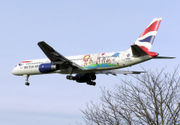
The Blue Peter special-paint British Airways Boeing 757-200
|
Since its formation in 1974, though to a limited extent until all aircraft were repainted, British Airways aeroplanes carried a Union Flag scheme painted on their tail fins. The original predominantly red tail scheme was changed with the launch of a new livery designed by the New York design agency, Landor Associates. The new tail was predominantly dark blue and carried the British Airways Coat of Arms. On 10 June 1997 they began to be repainted (and the planes re-named) with abstract world images, Delft pottery or Chinese calligraphy for example, relating to countries they fly to. This caused problems with air traffic control: previously controllers had been able to tell pilots to follow a BA plane, but because they were each painted in different colours they were harder to identify.
At a British Airways launch party in London Margaret Thatcher famously covered the tail fin of a model aircraft with the new "world art" design using her handkerchief. She slated it, claiming they made it look like a third world airline. "We fly the British flag, not these awful things."
On 6 June 1999, BA chief executive Bob Ayling announced that all BA planes would be repainted with the Chatham Dockyard Union Flag, based on a design first used on Concorde.
Cabins
United Kingdom internal flights
UK Domestic seat pitch is 31" on all aircraft and the seats are in a one-class configuration. Food on these services depends on the destination and time of day. On all UK Domestic services, a breakfast meal is served before 10am and after 10am there is a drinks service. There is a salad service on flights from Scotland to London.
Business UK has exactly the same service (same cabin) as UK Domestic, with a fully flexible ticket and lounge access.
Europe
Euro Traveller seat pitch is 31", except on Boeing 757 aircraft where it is 32" and Airbus A321 aircraft where it is 30". Food on board depends on the destination "band" (e.g. Band 1 to Paris, Band 3 to Rome, Band 4 to Athens). In-flight entertainment is offered on band 4 flights on aircraft with suitable equipment.
Club Europe Club Europe is the business class product of British Airways, offered on all shorthaul routes. Passengers have access to business lounges at most airports and are also served a full English breakfast in the mornings and afternoon tea later in the day. Seat pitch is 34".
International outside Europe
FIRST is the long haul first class product on British Airways and is offered only on BA's Boeing 777 and Boeing 747 aircraft. In it are thirteen or fourteen private "demi-cabins" with 6' 6" beds, in-seat power for laptops, personal phones, and entertainment facilities. Meals are available on demand. BA offers dedicated check-in facilities at some airports.
Club World is the longhaul business class product of British Airways. Passengers have access to business lounges at most airports. On 13 November 2006, British Airways launched a new Club World service, offering larger seats and a service revamp. The service offers a 6' 6" 20" wide flat bed with 24 seats on the 767-300ER, either 40 or 48 seats on the 777-200, and, since 2007 either 52 or 70 seats on the 747-400. British Airways is one of the few airlines to offer a fully flat bed in business class as well as first class.
World Traveller and World Traveller Plus are the two main economy classes offered internationally on British Airways. World Traveller is standard economy and offers a 31" seat pitch. World Traveller Plus is premium economy and, in comparison to World Traveller, offers a better (38") seat pitch, fewer seats abreast, and in-seat laptop power.
Special Cabin Configuration
In 2001, British Airways became the first carrier to introduce a 10 abreast economy class configuration on the Boeing 777, an aircraft which had been designed for 9 abreast seating. This utilised specially built narrow seats, and narrow aisles, and was applied to 3 GE engined 777-236ER (G-VIIO / MSN 29320, G-VIIP / MSN 29321 and G-VIIR / MSN 29322) used predominantly on Caribbean routes, but sometimes flown to and from Florida. Since BA piloted this development, the configuration has been emulated by Emirates Airline and China Southern.
Operations
British Airways is held in high standing internationally. Accordingly BA's major strategic and selection decisions are watched by competitors, and often mirrored by the industry. BA gains benefit from this: for example, the September 2007 order of 12 Airbus A380s were thought to have been sold at a 50% discount from list in view of the potential "landslide" impact on other potential purchasers.
BA is based at London Heathrow Airport in London, England. It also has a presence at Gatwick and previously had a significant hub at Manchester International Airport, but this was much reduced in 2007 after the sale of BA Connect, in common with operations from other UK airports. BA has succeeded in dominating Heathrow to the point that the airport is commonly referred to as Fortress Heathrow within both the airline and its competitors.
As an incumbent airline, BA had grandfather rights to around 36% of takeoff and landing slots at Heathrow, many of which are used for the lucrative trans-Atlantic market. Some competitors, such as Virgin Atlantic and bmi, assert that this stifles competition and some political think-tanks recommend an auction of slots. In recent years British Airways has been buying slots from other airlines including United Airlines, bmi, Brussels Airlines, GB Airways and Swiss International Air Lines, and now owns about 40% of slots at Heathrow.
Although British Airways describes itself as the 'National Carrier of the United Kingdom', it does not have a presence in Wales and services to all airports 'north of Watford' were severely truncated in March 2007. BA aims to fly UK passengers through its congested Heathrow and Gatwick hubs. However, this policy is now being successfully countered by foreign carriers such as Emirates, who fly direct from several UK provincial airports to Dubai, Abu Dhabi etc and onwards from those hubs to Asia and Australasia.
Traditionally viewed as a full fare airline, BA operations in some ways resemble those of a budget airline; notably in the February 2007 decision to charge up to £240 for a second piece of hold luggage.
BA CityFlyer is a subsidiary with Avro RJ100 aircraft based in Edinburgh, but operating mainly from London City Airport. BA CityFlyer operates around 250 flights per week at London City Airport.
In March 2008, BA will move most of its Heathrow operation to the new Terminal 5. A large majority of the move will happen during the night on 26 March, when one of the runways at Heathrow will be closed to enable trucks and staff to move almost the entire T1 operation, short-haul T4 operation, and all T3 operations not using Boeing 757 aircraft. In April, T4 long-haul services will move to T5 except for Australian services, which will move to the newly allocated Oneworld terminal at T3 in October. The remaining T1 services will move to T3 in June.
Subsidiaries and franchisees
Subsidiaries
- BA CityFlyer
- OpenSkies
British Airways is the full owner of Airways Aero Associations Limited, which operates the British Airways flying club and runs its own aerodrome under the British Airways brand at Wycombe Air Park, High Wycombe. With the creation of Open Skies between Europe and the United States in March of 2008, British Airways will begin a subsidiary airline called, OpenSkies (previously codenamed "Project Lauren"). It plans to offer business and economy flights from continental Europe to New York. The airline plans to start operations in June 2008.
Franchisees
- Comair, South Africa, franchisee since 1996.
- GB Airways, UK, franchisee since 1 February 1995 until 30 March 2008.
- Loganair, UK, franchisee since July 1994 until 25 October 2008.
- Sun Air, Denmark, franchisee since 1 August 1996.
Shareholdings
BA owns a 10% stake in Spanish airline Iberia. It raised its stake in Iberia from 9% to 10% by purchasing American Airlines' remaining shares. This 10% stake gives British Airways the right to appoint two board members.
It obtained a 15% stake in FlyBe when it sold its regional UK operation BA Connect to FlyBe in March 2007.
It owns a 10% stake in Eurostar (U.K.) Ltd. as part of the InterCapital and Regional Rail alliance that also includes SNCF, SNCB and National Express Group. Eurostar (U.K.) is the UK arm of Eurostar, the cross-Channel rail operator.
Cargo
BA is, through its subsidiary British Airways World Cargo, the world's twelfth-largest cargo airline based on total freight tonne-kilometers flown. BA World Cargo has global reach through the British Airways scheduled network. In addition to the main fleet, BA World Cargo wet lease three Boeing 747-400F dedicated freighter aircraft from Global Supply Systems on a multi-year basis, as well as utilising space on dedicated freighters operated by other carriers on European services. Dedicated freighter services allow the airline to serve airports not connected to the scheduled network, such as London Stansted, Glasgow Prestwick, Frankfurt-Hahn, Vitoria and Seoul.
British Airways opened its £250m World Cargo centre, Ascentis, at Heathrow in 1999. As an advanced automated freight handling centre, it can handle unusual and premium cargo, and fresh produce, of which it handles over 80,000 tons per year. BA World Cargo also handles freight at London's Gatwick and Stansted airports, and, through its partner British Airways Regional Cargo, at all of the main regional airports throughout the UK. On July 3, 2007 BA World Cargo announced it would launch new services to Jinnah International Airport, Karachi and Allama Iqbal International Airport, Lahore in Pakistan using Boeing 727s via Bahrain.
Loyalty Programs
Executive Club
The Executive Club is British Airways' main frequent flyer programme. It is part of the network of frequent flyer programs in the Oneworld alliance. The Executive Club has three tiers of membership: Blue, Silver, Gold. The benefits of the Silver and Gold cards include access to airport lounges and dedicated reservation lines. Unlike most airlines' frequent flyer programs, the Executive Club keeps separate account of the redeemable BA Miles and the loyalty Tier Points. Flying in higher Classes of Service, i.e. Premium Economy, Business or First, will earn both BA Miles and Tier Points, whereas Tier Points can only be earned for "Eligible Flights". A Full Fare Economy (Y/B/H) fare or any premium cabin fare will be considered as eligible flight. Discounted economy fares will only earn 25% BA Miles and no tier points. Membership of the Executive Club will be extended annually upon attaining the relevant number of Tier Points. For instance, to maintain the Silver Executive Club will require 4 Premium Economy Returns between the UK and the US Eastern Seaboard.
Premier
In addition to the Executive Club, British Airways operates an invitation-only Premier program.
Incidents and accidents
- On 10 September 1976 a Trident 3B on British Airways Flight 476, flying from London Heathrow to Istanbul, collided in mid-air with a Inex Adria DC9-32 near Zagreb, Croatia, resulting in the 1976 Zagreb mid-air collision. All 54 passengers and 9 crew members on the BA aircraft died.
- On 24 June 1982, Flight 9, a Boeing 747-200, G-BDXH, City of Edinburgh flew through a cloud of volcanic ash and dust from the eruption of Mount Galunggung, causing extensive damage to the aircraft, including the failure of all four engines. The aircraft managed to glide out of the dust cloud and restart all of its engines, allowing it to make an emergency landing at Jakarta. No-one was injured.
- On 10 June 1990, Flight 5390, a BAC 1-11 flight between Birmingham and Málaga, suffered a windscreen blowout due to the fitting of incorrect bolts two days previously. The Captain suffered minor injuries despite being partially sucked out of the aircraft but the co-pilot landed the plane safely at Southampton Airport.
- On 2 August 1990, Flight 149 landed at Kuwait International Airport four hours after the Iraqi invasion of Kuwait, leading to the capture of the passengers and crew, and the destruction of the aircraft.
- On 29 December 2000, Flight 2069 from London Gatwick Airport to Nairobi experienced a hijack attempt whilst flying over Sudan. A Kenyan student with a mental illness burst into the cockpit of the Boeing 747. As three crew fought to restrain the man, the auto-pilot became disengaged and the jet dropped 10,000 feet with 398 passengers on board. However, with the help of a couple of passengers, the pilots recovered the aircraft, successfully restrained the Kenyan with handcuffs and the plane landed safely.
- On 19 February 2005, the No. 2 engine of a Boeing 747-400 G-BNLG surged and suffered internal damage just after take off from Los Angeles on a flight to London Heathrow with 16 crew and 351 passengers on board. The crew shut the engine down and continued the climb and continued the flight, in line with BA's standard operating procedures for 4 engined aircraft. Because it was unable to attain normal cruising speeds and altitudes, the aircraft diverted to Manchester, England. The United States Federal Aviation Administration had been critical of the Captain's decision and accused BA of operating the aircraft in an unairworthy condition. In June 2006 the UK Air Accidents Investigation Branch recommended that the UK and US authorities review the policy on flight continuation and give clear guidance. This has not happened but the FAA have accepted the United Kingdom Civil Aviation Authority’s determination that the aircraft was not unairworthy.
- On 10 August 2006 the airline cancelled a large number of its flights to and from London Heathrow Airport due to a foiled terrorist plot to destroy jet airliners travelling from the United Kingdom to the United States. British Airways was one of those airlines that was targeted by the terrorists. Two days later on 12 August 2006 the owner and operator of London Heathrow, BAA ordered airlines using the airport to make a 30% reduction in departing passenger flights (something BA was already having to do as passengers missed flights due to the extra time it took to clear security), to help reduce delays and cancellations. BA would later say the disruption cost it £40 million and forced it to cancel 1,280 flights between 10 and 17 August.
- On 17 January 2008 an incident occured involving a British Airways Boeing 777 flight number BA038 from Beijing to London. The plane landed short of the south runway, four people suffered minor injuries.
http://www.timesonline.co.uk/tol/news/uk/article3204607.ece Heathrow closed after aircraft lands short of runway]</ref>
Controversies
- In October 2006, the British Airways cross controversy was a dispute over the right of a Christian check-in worker to wear a visible symbol of faith.
- In November 2006, it was revealed that British Airways has a policy of not seating adult male passengers next to unaccompanied children, even if the child's parents are elsewhere on the plane. This led to accusations that the airline considers all men to be potential paedophiles.
- British Airways was announced by the Association of European Airlines as having lost the most luggage in 2006 compared to other major European airlines. For every 1000 passengers carried, it lost 23 bags, 46% more than the average.
- In April 2007, British Airways showed a version of Casino Royale. with footage of Richard Branson removed and obscured a tail fin of a Virgin aircraft. A representative of EON Productions, producer of most of the Bond films, said Barbara Broccoli considered removing BA from their list of suppliers. It was not the first time that BA had shown edited inflight movies with rivals removed from them.
